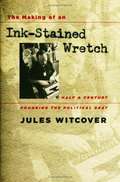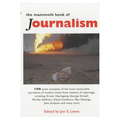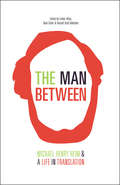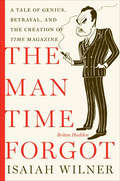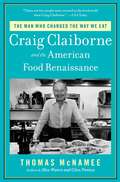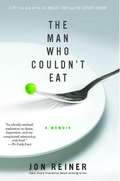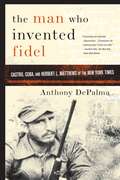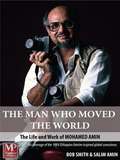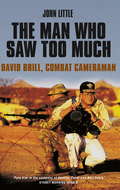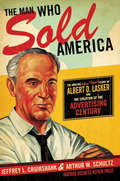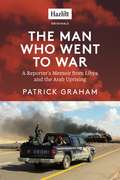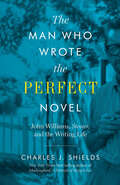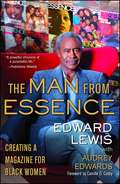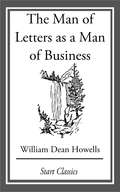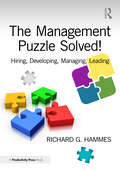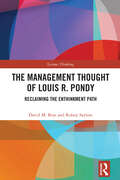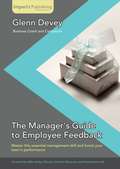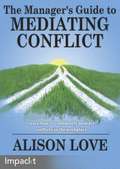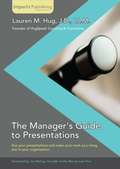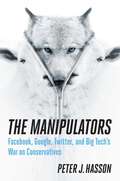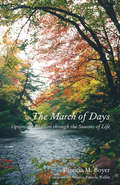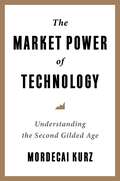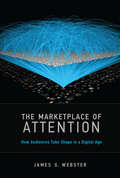- Table View
- List View
The Making of an Ink-stained Wretch: Half a Century Pounding the Political Beat
by Jules WitcoverThe jovial Witcover, one of the original "boys on the bus," traces his path across 56 years or political reporting and analysis. His insider memoir looks at the changing role and style of reporters, commentators, and other shapers of public opinion and gives a personal gloss to public events spanning administrations from Eisenhower to George W. Bush. Annotation ©2006 Book News, Inc., Portland, OR (booknews.com)
The Mammoth Book of Journalism
by Jon E. LewisThe newspaper has recorded and influenced modern history like nothing else on earth. From The Washington Post's exposure of Watergate, Tom Wolfe's 1960's social documentary in The Electric Cool-Aid Acid Test to Robert Fisk uncovering the slaugher at Chatila, all the articles included here are reportage from the frontline of life. The 100 dispatches collected here are reports which have caught most vividly the greatest events of the twentieth century, the editorials which have changed our thinking, the criticisms which have penetrated most deeply into contemporary culture. Most of all, they offer a snapshot of these modern times.
The Mammoth Book of Journalism (Mammoth Books #380)
by Jon E. LewisThe newspaper has recorded and influenced modern history like nothing else on earth. From The Washington Post's exposure of Watergate, Tom Wolfe's 1960's social documentary in The Electric Cool-Aid Acid Test to Robert Fisk uncovering the slaugher at Chatila, all the articles included here are reportage from the frontline of life. These are the editorials that have changed our thinking and the criticisms that have penetrated most deeply into contemporary culture. Most of all, they offer a snapshot of these modern times.
The Man Between
by Michael Henry Heim Sean Cotter Esther Allen Russell Scott ValentinoWhen Michael Henry Heim--one of the most respected translators of his generation--passed away in the fall of 2012, he left behind an astounding legacy. Over his career, he translated two-dozen works from eight different languages, including books by Milan Kundera, Dubravka Ugresic, Hugo Claus, and Anton Chekov.But Mike, as he was known to his legion of friends, was much more than that. His classes at UCLA on translation inspired a new generation of translators, and his work altering the way translation is viewed in the university will impact the livelihood of translators for decades to come.If that weren't enough, upon his death it was revealed that Heim was the anonymous donor responsible for the PEN Translation Fund--the largest fund in America supporting up-and-coming translators.Hundreds of people in the literary community were impacted by Heim's life and actions, and this book is a small way of honoring this quiet, humble man who, among many other things, is responsible for the title The Unbearable Lightness of Being (and all its variants) entering the English idiom.Comprising a number of different sections--a short autobiography, pieces from authors he worked with, worksheets detailing his teaching and translation techniques--The Man Between opens a window onto the life and teachings of Michael Henry Heim, and, similar to David Bellos's Is That a Fish in Your Ear?, will be of great interest to anyone interested in language, international culture, and the art of translation.
The Man Time Forgot: A Tale of Genius, Betrayal, and the Creation of Time Magazine
by Isaiah WilnerAn “illuminating biography” of the forgotten, tragic genius who founded Time magazine with his friend and fierce rival Henry Luce (The New Yorker).Friends, collaborators, and childhood rivals, Briton Hadden and Henry R. Luce were not yet twenty-five when they started Time, the first newsmagazine, at the outset of the Roaring Twenties. By age thirty, they were both millionaires, having laid the foundation for a media empire. But their partnership was explosive and their competition ferocious, fueled by envy as well as love. When Hadden died at the age of thirty-one, Luce began to meticulously bury the legacy of the giant he was never able to best.In this groundbreaking, stylish, and passionate biography, Isaiah Wilner paints a fascinating portrait of Briton Hadden—genius and visionary—and presents the first full account of the birth of Time, while offering a provocative reappraisal of Henry R. Luce, arguably the most significant media figure of the twentieth century.“A riveting narrative . . . richly detailed . . . part This Side of Paradise, part Citizen Kane.” —The Wall Street Journal“[A] scintillating biography . . . a perceptive psychological study and cultural history, with a touch of ink-stained romanticism.” —Publishers Weekly“With access to the Time archives and unpublished interviews and correspondence, Wilner offers all the excitement of a new media enterprise launched in the Roaring Twenties by two fascinating figures.” —Booklist
The Man Who Changed the Way We Eat
by Thomas McnameeIn the 1950s, America was a land of overdone roast beef and canned green beans--a gastronomic wasteland. Most restaurants relied on frozen, second-rate ingredients and served bogus "Continental" cuisine. Authentic French, Italian, and Chinese foods were virtually unknown. There was no such thing as food criticism at the time, and no such thing as a restaurant critic. Cooking at home wasn't thought of as a source of pleasure. Guests didn't chat around the kitchen. Professional equipment and cookware were used only in restaurants. One man changed all that. From the bestselling author of Alice Waters and Chez Panisse comes the first biography of the passionate gastronome and troubled genius who became the most powerful force in the history of American food--the founding father of the American food revolution. From his first day in 1957 as the food editor of the New York Times, Craig Claiborne was going to take his readers where they had never been before. Claiborne extolled the pleasures of exotic cuisines from all around the world, and with his inspiration, restaurants of every ethnicity blossomed. So many things we take for granted now were introduced to us by Craig Claiborne--crÈme fraÎche, arugula, balsamic vinegar, the Cuisinart, chef's knives, even the salad spinner. He would give Julia Child her first major book review. He brought Paul Bocuse, the Troisgros brothers, Paul Prudhomme, and Jacques PÉpin to national acclaim. His $4,000 dinner for two in Paris was a front-page story in the Times and scandalized the world. And while he defended the true French nouvelle cuisine against bastardization, he also reveled in a well-made stew or a good hot dog. He made home cooks into stars--Marcella Hazan, Madhur Jaffrey, Diana Kennedy, and many others. And Craig Claiborne made dinner an event--whether dining out, delighting your friends, or simply cooking for your family. His own dinner parties were legendary. Craig Claiborne was the perfect Mississippi gentleman, but his inner life was one of conflict and self-doubt. Constrained by his position to mask his sexuality, he was imprisoned in solitude, never able to find a stable and lasting love. Through Thomas McNamee's painstaking research and eloquent storytelling, The Man Who Changed the Way We Eat unfolds a history that is largely unknown and also tells the full, deep story of a great man who until now has never been truly known at all.
The Man Who Couldn't Eat
by Jon ReinerIn this beautifully written memoir, both gut-wrenching and inspiring, award-winning writer Jon Reiner tells the story of his agonizing battle with Crohn's disease--and the extraordinary places his hunger and obsession with food took him. I'm a glutton in a greyhound's body, a walking contradiction, in the grip of the one thing I can't have--food, writes Reiner, who details what happens when that which keeps you alive, that bonds us together and marks life's special occasions, becomes a toxic substance, an inflammatory invader. His unvarnished account depicts an explosive medical emergency, a marriage in crisis, children faced with grown-up fears, a man at a life-and-death crossroads sifting through his past and his present. And it captures a tough, courageous climb out of hopelessness as Reiner began a process of healing in body and mind, discovering a renewed appetite, any way he could manage it, for the things that truly matter most. crossroads sifting through his past and his present. And it shows us a tough, courageous climb out of despair and hopelessness. Aided by the loving kindness of family, friends, and strangers and by a new approach to food, Reiner began a process of healing in body and mind. Most of all, he chose life--and a renewed appetite, any way he could manage it, for the things that truly matter most. present. And it shows us a slow, courageous climb out of despair and hopelessness. Aided by the loving kindness of family, friends, and strangers and by a new approach to food, Reiner began a process of healing in body and mind. Most of all, he chose life--and a renewed appetite, any way he could manage it, for the things that truly matter most.
The Man Who Invented Fidel
by Anthony DepalmaIn 1957, Herbert L. Matthews of the New York Times, then considered one of the premiere foreign correspondents of his time, tracked down Fidel Castro in Cuba's Sierra Maestra mountains and returned with what was considered the scoop of the century. His heroic portrayal of Castro, who was then believed dead, had a powerful effect on American perceptions of Cuba, both in and out of the government, and profoundly influenced the fall of the Batista regime. When Castro emerged as a Soviet-backed dictator, Matthews became a scapegoat; his paper turned on him, his career foundered, and he was accused of betraying his country. In this fascinating book, New York Times reporter DePalma investigates the Matthews case to reveal how it contains the story not just of one newspaperman but of an age, not just how Castro came to power but how America determines who its enemies are. He re-creates the atmosphere of revolutionary Cuba and Cold War America, and clarifies the facts of Castro's ascension and political evolution from the many myths that have sprung up around them. Through a dramatic, ironic, in ways tragic story, The Man Who Invented Fidel offers provocative insights into Cuban politics, the Cuban-American relationship, and the many difficult balancing acts of responsible journalism.
The Man Who Moved the World: The Life and Work of Mohamed Amin
by Bob Smith Salim Amin Michael BuerkMohamed Amin was the most famous photo journalist in the world, making the news as often as he covered it. His coverage of the 1984 Ethiopian famine proved so compelling that it inspired a collective global conscience and became the catalyst for the greatest-ever act of giving--the "We Are the World" campaign. Unquestionably, it also saved the lives of millions of men, women and children. In a career spanning more than 30 years, Mo covered every major event in Africa and beyond, braving torture, surviving bombs and bullets to emerge as the most decorated news cameraman of all time. But his frenetic life was cut tragically short when, in November, 1996, hijackers took over an Ethiopian airliner forcing it to ditch in the Indian Ocean killing 123 passengers and crew. Mo died on his feet still negotiating with the terrorists.
The Man Who Saw Too Much: David Brill, Combat Cameraman
by John LittleThis is the story of David Brill, one of the very best of Australian cameramen - past and present. He is in the same company as Damien Parer and Neil Davis.Over the past forty years he has covered wars and disasters all over the world. He filmed the fall of Saigon. He was in Moscow during the collapse of communism. He has covered countless other conflicts and natural disasters in Asia, Africa and North and South America.He has been single-mindedly dedicated to the pursuit of his craft: to get the story, get the film - always to preserve and present the human dimension, no matter how large or mindless the conflict or event.David Brill has paid a high price for this uncompromising style. He has two failed marriages, and at times has been overcome by demons such as alcohol. This biography is also a great adventure story, a journey through war zones and various hell holes of the world. And it is an inside look at what makes some people follow a profession where their life is on the line - as a standard feature of their day.
The Man Who Sold America
by Jeffrey L. Cruikshank Arthur W. SchultzWe live in an age of persuasion. Leaders and institutions of every kind--public and private, large and small--must compete in the marketplace of images and messages. This has been true since the advent of mass media, from broad circulation magazines and radio through the age of television and the internet. Yet there have been very few true geniuses at the art of mass persuasion in the last century. In public relations, Edward Bernays comes to mind. In advertising, most Hall-of-Famers--J. Walter Thomson, David Ogilvy, Bill Bernbach, Bruce Barton, Ray Rubicam, and others--point to one individual as the "father" of modern advertising: Albert D. Lasker. And yet Lasker--unlike Bernays, Thomson, Ogilvy, and the others--remains an enigma. Now, Jeffrey Cruikshank and Arthur Schultz, having uncovered a treasure trove of Lasker's papers, have written a fascinating and revealing biography of one of the 20th century's most powerful, intriguing, and instructive figures. It is no exaggeration to say that Lasker created modern advertising. He was the first influential proponent of "reason why" advertising, a consumer-centered approach that skillfully melded form and content and a precursor to the "unique selling proposition" approach that today dominates the industry. More than that, he was a prominent political figure, champion of civil rights, man of extreme wealth and hobnobber with kings and maharajahs, as well as with the likes of Albert Einstein and Eleanor Roosevelt. He was also a deeply troubled man, who suffered mental collapses throughout his adult life, though was able fight through and continue his amazing creative and productive activities into later life.This is the story of a man who shaped an industry, and in many ways, shaped a century.
The Man Who Went to War: A Reporter's Memoir from Libya and the Arab Uprising
by Patrick GrahamAlmost a decade since deciding to give up war reporting full-time, and at the unexpected prodding of his wife, award-winning journalist Patrick Graham travels to the heart of the Libyan Revolution and the Arab Spring. He delivers a story by turns harrowing and comic, rich in both dramatic, on-the-ground reportage and historical detail, of a nation on the brink of transformation. “If you’re a recovering journalist listening to reports of a distant war on the radio, then you know, with the kind of arrogant certainty that sometimes irritates your wife, what you would be doing during these moments because you’re already there in your head. . . . I may have been at home in my kitchen wearing an apron, but my avatar had been doing some heroic work around the globe. Which is why I found myself mocking the guy on the radio: “For fuck’s sake, at least get to Benghazi!” It was around that time that my wife, who had walked in unnoticed, said, “Why don’t you go?” Within a few days of his wife’s suggestion, Graham was on a plane. It had been a while since he had last reported on a war. Though he lacked the security or credentials of a formal assignment, and was more than a little out of practice, he improvised his way from Egypt, then experiencing its own Arab Spring upheavals, and across the frontier into Libya. The result is an intimate eyewitness account – equal parts harrowing and hilarious – of the Libyan revolution as seen from the heart of the uprising in Benghazi. As ragtag militias try to beat back the assaults of Gaddafi’s troops, Graham introduces us to Libyan civilians with haunted pasts and uncertain futures, each of whom must decide whether they, too, will go to war. Meanwhile, Graham encounters both old colleagues and rookie journalists, forcing him to ask questions about the changing nature of war reportage in the age of social media. With a fascinating detour that explores the rebellion’s intellectual and spiritual roots in the Sanusi, a Sufi Muslim political order, The Man Who Went to War is a penetrating and engrossing story of a country on the brink of transformation.
The Man Who Wrote the Perfect Novel: John Williams, Stoner, and the Writing Life
by Charles J. ShieldsAn &“engrossing&” biography of a brilliant novelist underappreciated in his own time who became a twenty-first-century bestseller, from the New York Times–bestselling author (The New Yorker). When Stoner was published in 1965, the novel sold only a couple of thousand copies before disappearing with hardly a trace. Yet the quietly powerful tale of Midwestern college professor William Stoner, whose life becomes a parable of solitude and anguish, eventually found an admiring audience in America and especially in Europe. The New York Times called Stoner &“a perfect novel,&” and a host of writers and critics, including Colum McCann, Julian Barnes, Bret Easton Ellis, Ian McEwan, Emma Straub, Ruth Rendell, C.P. Snow, and Irving Howe, praised its artistry. The New Yorker deemed it &“a masterly portrait of a truly virtuous and dedicated man.&” This biography traces the life of Stoner&’s author, John Williams. Charles J. Shields follows the whole arc of Williams&’s life, which in many ways paralleled that of his titular character, from their shared working-class backgrounds to their undistinguished careers in academia. Shields vividly recounts Williams&’s development as an author, whose other works include the novels Butcher&’s Crossing and Augustus (for the latter, Williams shared the 1972 National Book Award). Shields also reveals the astonishing afterlife of Stoner, which garnered new fans with each American reissue, and then became a bestseller all over Europe after a Dutch publisher brought out a translation in 2013. Since then, Stoner has been published in twenty-one countries and sold over a million copies. &“Like Williams, Shields know how to tell a good story, one that will appeal especially to those interested in the ins and outs of the publishing industry and the ups and downs of a writer&’s life.&” —Los Angeles Review of Books
The Man Who Wrote the Perfect Novel: John Williams, Stoner, and the Writing Life
by Charles J. ShieldsAn &“engrossing&” biography of a brilliant novelist underappreciated in his own time who became a twenty-first-century bestseller, from the New York Times–bestselling author (The New Yorker). When Stoner was published in 1965, the novel sold only a couple of thousand copies before disappearing with hardly a trace. Yet the quietly powerful tale of Midwestern college professor William Stoner, whose life becomes a parable of solitude and anguish, eventually found an admiring audience in America and especially in Europe. The New York Times called Stoner &“a perfect novel,&” and a host of writers and critics, including Colum McCann, Julian Barnes, Bret Easton Ellis, Ian McEwan, Emma Straub, Ruth Rendell, C.P. Snow, and Irving Howe, praised its artistry. The New Yorker deemed it &“a masterly portrait of a truly virtuous and dedicated man.&” This biography traces the life of Stoner&’s author, John Williams. Charles J. Shields follows the whole arc of Williams&’s life, which in many ways paralleled that of his titular character, from their shared working-class backgrounds to their undistinguished careers in academia. Shields vividly recounts Williams&’s development as an author, whose other works include the novels Butcher&’s Crossing and Augustus (for the latter, Williams shared the 1972 National Book Award). Shields also reveals the astonishing afterlife of Stoner, which garnered new fans with each American reissue, and then became a bestseller all over Europe after a Dutch publisher brought out a translation in 2013. Since then, Stoner has been published in twenty-one countries and sold over a million copies. &“Like Williams, Shields know how to tell a good story, one that will appeal especially to those interested in the ins and outs of the publishing industry and the ups and downs of a writer&’s life.&” —Los Angeles Review of Books
The Man from Essence: Creating a Magazine for Black Women
by Edward LewisEssence magazine is the most popular, well respected, and largest circulated black women&’s magazine in history. Largely unknown is the remarkable story of what it took to earn that distinction.The Man from Essence depicts with candor and insight how Edward Lewis, CEO and publisher of Essence, started a magazine with three black men who would transform the lives of millions of black American women and alter the American marketplace. Throughout Essence&’s storied history, Ed Lewis remained the cool and constant presence, a quiet-talking corporate captain and business strategist who prevailed against the odds and the naysayers. He would emerge to become the last man standing—the only partner to survive the battles that raged before the magazine was sold to Time, Inc. in the largest buyout of a black-owned publication by the world&’s largest publishing company. By the time Lewis did the deal with Time, the little magazine that limped from the starting gate in 1970 with a national circulation of 50,000, had grown into a powerhouse with a readership of eight million. The story of Essence is ultimately the story of American business, black style. From constant battles with a racist advertising community to hostile takeover attempts, warring partners packing heat, mass firings, and mass defections—all of which revealed inherent challenges in running a black business—the saga is as riveting as any thriller. In this engaging business memoir, Ed Lewis tells the inspiring story of how his own rise from humble South Bronx beginnings to media titan was shaped by the black women and men in his life. This in turn helped shape a magazine that has changed the face of American media.
The Man of Letters as a Man of Busine
by William Dean HowellsHe can say that, as the thing is, unless he sells his art he cannot live, that society will leave him to starve if he does not hit its fancy in a picture, or a poem, or a statue; and all this is bitterly true. He is, and he must be, only too glad if there is a market for his wares.
The Management Puzzle Solved!: Hiring, Developing, Managing, Leading
by Richard G. HammesMost often managers come up through the ranks of employees and are chosen because of their success, drive, abilities, education, other accomplishments, and personal factors. However, collectively their accomplishments as employees do not necessarily prepare them for managing and leading. Completing tasks is different from energizing and motivating others to perform. Often the best "doers" are not the best managers. In managing and leading, it often is the mid-level or average performer that is more effective. They may not achieve at the highest level as an employee, but they have qualities that fit with the characteristics of successful managers and leaders. What is needed regardless of prior experience is training and guidance to be a successful manager and leader. What they need is a tool kit to assist them in transitioning to management and, more broadly, to grow in the role over many years. The contents of this book are based on 30 years of client-proven consulting work with companies from start-up to Fortune 100. The information, methods, forms, and other ideas have been honed and modified to provide a universally implementable series of programs and processes that will assist managers and leaders at all levels of organizations to more effectively lead and manage. A key value of The Management Puzzle Solved! is that useful management information is communicated in a concise, informative, non-time intensive format. Each section can be read and digested readily and serve as an ongoing reference for managers as specific needs or concerns arise or just to broaden knowledge.This book is a mini-management course in a readable and compact format. It provides managers with information to interview candidates more effectively, deal with the day-to-day management of employees, provide leadership for the organization, manage employee performance, facilitate meetings effectively, enhance communication, promote team functioning, and implement change more smoothly. Rather than the latest fad, this field-tested set of management tools provides ideas and techniques that have been implemented in hundreds of companies with thousands of managers and employees to help you manage and lead effectively.
The Management Thought of Louis R. Pondy: Reclaiming the Enthinkment Path (Systems Thinking)
by David M. BojeLouis R. Pondy was a leading management and organizational studies scholar whose work on open systems helped launch and define the future of the field. This book offers an assessment of Pondy’s contribution, through critical reflection on what happened to the relationship between conflict theory and “beyond open systems.” Exploring the ways in which Louis R. Pondy theorizes conflict and systems, and how he challenged the status quo paradigms, this book offers a historical analysis on Pondy’s work and the relation to contemporary management theory. The author develops a Triple Loop framework, building on Pondy’s theories as well as the work of Gregory Batesom, to demonstrate a beyond-open-systems approach and existing single- or double-loop systems. Demonstrating the value and legacy of Louis R. Pondy, this book will have international appeal to researchers, academics and students across management disciplines and organizational studies, including systems thinking and conflict resolution.
The Manager's Guide to Employee Feedback
by Glenn DeveyBook Description Expert Business Coach and trainer Glenn Devey shares with you his inside secrets to delivering the best feedback to engage your staff in their development journey. Critical to your success as a manager is your ability to consistently raise the performance of your team members, and the best leaders let their staff know exactly how they are measuring up. This friendly, engaging guide will give you a shortcut to a management skill that is valuable and rare, but essential to make your mark as a great leader. Let Glenn show you how to master his tried and tested feedback models, and you'll be able to deal confidently and fairly with your staff even when stakes are high. Step by step, you'll learn to deliver professional and effective reprimands with minimal stress, apply subtle psychological tactics to steer your team towards success, diplomatically deliver feedback to senior leaders, articulate your feedback to keep your team motivated, and deal with difficult feedback situations. Packed with tips, advice, real life case studies and written with humor along the way, this accessible guide will help you to fulfill your management potential. Product Description Editorial Reviews From the Foreword: "Glenn Devey presents a range of strategies to help us in this development. His engaging style, his authentic appreciation of the challenges this presents and his enthusiastic encouragement to us all make this book a very accessible and enjoyable read. He draws on his own experiences with a refreshing honesty and his highly developed coaching and mentoring skills are in evidence as he encourages us to think for ourselves and work things out through experience as opposed to calling on us to simply take his word for it." - Mike Hurley, Management Development Consultant and Business Coach About the Author Glenn currently works as a management consultant building on an industrial career spanning almost thirty years. After beginning his career in the Telecoms industry, he moved into the Automotive industry where he spent seventeen years working in Engineering Management leading small and large teams of engineers working on complex new products. He resigned his corporate position in 2007 to work freelance as a trainer, coach and consultant following a passion for personal and professional development. Since then he has worked with clients such as Argos, Royal Mail and Starbucks, training the next generation of new managers and also working as an executive coach to senior leaders in business.
The Manager's Guide to MEDIATING CONFLICT
by Alison LoveIf you are a manager who wants to develop their conflict management skills and gain a greater understanding on how meditation offers a clear framework for effective conflict resolution, this book is for you.
The Manager's Guide to Presentations
by Lauren M. HugBook Description Lauren Hug, founder of HugSpeak Coaching & Consulting, has been helping people reach and motivate audiences for 20 years. In this concise, friendly guide, she condenses her years of presentation expertise from the courtroom to the boardroom. Your presentations are a crucial part of establishing yourself as a leader. Developing a commanding presence and exceptional public speaking skills will mark you as a rising star within your organization. And it doesn't have to be daunting. Lauren will teach you how to speak with confidence, whether you're presenting to your employees, your boss or external stakeholders. This accessible, practical book will walk you through the process step by step, from planning and developing your content, through mastering your materials, to delivering a dynamic performance and reaping the rewards in your career. With interactive exercises and templates, you'll learn how to embrace your signature speaking style, engage your audience, craft compelling content and speak like a pro. Along the way, you'll find yourself building relationships with team members and bosses alike, and developing valuable insights into your strengths as a manager. Through her positive and collaborative coaching approach, described as empowering, life-changing, and therapeutic, Lauren will help you shine as both a leader and a presenter. Product Description Editorial Reviews From the Foreword: "This book is a must read for any new manager entering the business world. This book is not about gimmicks, nor does it become a self-help book. This book is about success and it provides its readers with the tools they need to achieve such success. And if you read this book and take its message to heart, you will never have to picture another audience in their underwear again. That's how priceless this book is." - Joe Murray, Founder of the Murray Law Firm About the Author An accomplished speaker, writer and thinker, Lauren Hug has helped people reach and motivate audiences for 20 years. For the past decade, she has applied analytical and communication skills to the branding, messaging and market research needs of businesses; big and small. Presentation experience from the courtroom to the boardroom, involvement with dozens of corporate campaigns, insights from analyzing research and cultural sensitivity from traveling and living abroad, all inform her unique perspective on the topic. Having discovered her gifts for public speaking, research and strategy through her high school speech team, Lauren has a passion for helping students, as well as professionals, develop those crucial skills. Lauren is a licensed attorney and certified mediator whose academic credentials include an LL.M. with merit from the University of London, a J.D. with honors from the top-20 University of Texas School of Law, and a Bachelor of Journalism and Bachelor of Arts in Spanish from the University of Texas.
The Manipulators: Facebook, Google, Twitter, and Big Tech's War on Conservatives
by Peter J. HassonFor better or for worse, Google and social media—&“Big Tech,&” collectively—have become the new public square. Unfortunately, this public square has a watchful referee standing behind them, ready and waiting to blow the whistle if they veer too far from the preferred narrative. Americans have given these companies enormous power to select the information they read, share and discuss with their neighbors and friends. We&’ve gotten so used to it, we forget to notice that Big Tech is sifting through the available information and narrowing—and prioritizing—our choices. What happens when that power is weaponized for political ends? Although Big Tech positioned itself initially as providing politically neutral platforms, the truth is that this is no longer the case—far from it. Daily Caller reporter Peter Hasson reveals in The Manipulators that Big Tech is using its huge financial and technological power to severely restrict access to conservative voices and ideas and to rig public debate in favor of America&’s political left wing. This happens in two ways: 1) By censoring and suppressing right-of-center voices and ideas, which restricts access to information that counters the progressive narrative 2) By purposefully amplifying left-wing voices and ideas, which creates the false impression that public consensus lines up with progressive orthodoxy.
The March of Days: Optimistic Realism through the Seasons of Life
by Patricia M. BoyerAlthough Patricia M. Boyer won a scholarship to McMaster University with the highest mathematics marks in Ontario and graduated at age 19, literature and languages were her specialty. She first worked as a public librarian, next as a secondary school teacher, then as a newspaper editor. A community leader in arts and theatre, Patricia was devoted to human rights action in her local community and around the world, church work, drama, the education of children with disabilities, and music. Each week she wrote a newspaper column inspired by episodes in the world around her, both local and global. She rewarded readers through articles infused with learning from literature, astute sensibility to human psychology, and balanced insights on the tragedies and comedies of life’s passing parade. Patricia Boyer summed up her approach to life as "optimistic realism". This collection of the best of her celebrated columns, organized through the twelve months of the year or "the march of days", includes reflections on seasonal celebrations, changing atmospheres of nature, and calendar milestones in the human cycle. A number of these concise yet poignant writings will move many readers with nostalgia as they evoke the happy events and tragic developments of the Sixties and Seventies. All of them, however, convey the wisdom of a woman whose message of optimistic realism endures like a timeless guide to living a satisfying life in the real world today.
The Market Power of Technology: Understanding the Second Gilded Age
by Mordecai KurzSince the 1980s, the United States has regressed to a level of economic inequality not seen since the Gilded Age in the late nineteenth century. At the same time, technological innovation has transformed society, and a core priority of public policy has been promoting innovation. What is the relationship between economic inequality and technological change?Mordecai Kurz develops a comprehensive integrated theory of the dynamics of market power and income inequality. He shows that technological innovations are not simply sources of growth and progress: they sow the seeds of market power. In a free market economy with intellectual property rights, firms’ control over technology enables them to expand, attain monopoly power, and earn exorbitant profits. Competition among innovators does not eliminate market power because technological competition is different from standard competition; it results in only one or two winners. Kurz provides a pioneering analysis grounded on quantifying technological market power and its effects on inequality, innovation, and economic growth. He outlines what causes market power to rise and fall and details its macroeconomic and distributional consequences.Kurz demonstrates that technological market power tends to rise, increasing inequality of income and wealth. Unchecked inequality threatens the foundations of democracy: public policy is the only counterbalancing force that can restrain corporate power, attain more egalitarian distribution of wealth, and make democracy compatible with capitalism. Presenting a new paradigm for understanding today’s vast inequalities, this book offers detailed proposals to redress them by restricting corporate mergers and acquisitions, reforming patent law, improving the balance of power in the labor market, increasing taxation, promoting upward mobility, and stabilizing the middle class.
The Marketplace of Attention: How Audiences Take Shape in a Digital Age (The\mit Press Ser.)
by James G. WebsterHow do media find an audience when there is an endless supply of content but a limited supply of public attention?Feature films, television shows, homemade videos, tweets, blogs, and breaking news: digital media offer an always-accessible, apparently inexhaustible supply of entertainment and information. Although choices seems endless, public attention is not. How do digital media find the audiences they need in an era of infinite choice? In The Marketplace of Attention, James Webster explains how audiences take shape in the digital age.Webster describes the factors that create audiences, including the preferences and habits of media users, the role of social networks, the resources and strategies of media providers, and the growing impact of media measures—from ratings to user recommendations. He incorporates these factors into one comprehensive framework: the marketplace of attention. In doing so, he shows that the marketplace works in ways that belie our greatest hopes and fears about digital media.Some observers claim that digital media empower a new participatory culture; others fear that digital media encourage users to retreat to isolated enclaves. Webster shows that public attention is at once diverse and concentrated—that users move across a variety of outlets, producing high levels of audience overlap. So although audiences are fragmented in ways that would astonish midcentury broadcasting executives, Webster argues that this doesn't signal polarization. He questions whether our preferences are immune from media influence, and he describes how our encounters with media might change our tastes. In the digital era's marketplace of attention, Webster claims, we typically encounter ideas that cut across our predispositions. In the process, we will remake the marketplace of ideas and reshape the twenty-first century public sphere.
